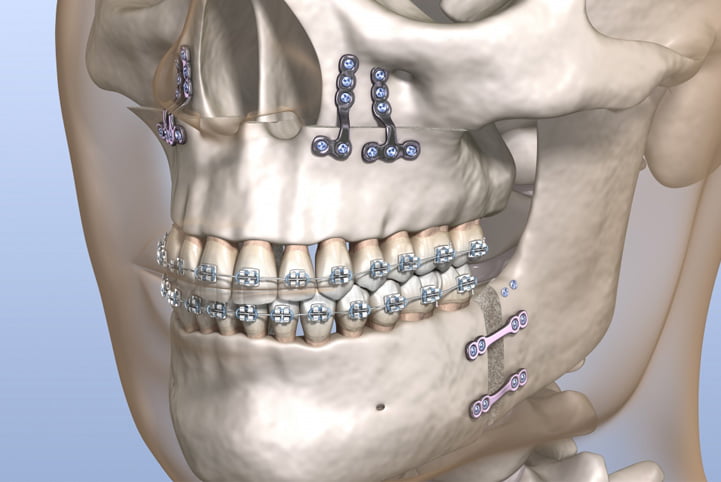Orthognathic Surgery
Orthognathic surgery is a specialized procedure that focuses on the correct opening and closing of the upper and lower jaw. This surgical intervention helps improve essential functions such as speech, chewing, swallowing, and respiration. Additionally, it plays a crucial role in treating sleep-related issues caused by misalignment between the upper and lower jaw.

What is Orthognathic Surgery?
The jaw is the area where many functions such as chewing, speaking, breathing, tasting or mimicking take place. It covers two-thirds of the face. Orthognathic surgery is the surgical department where developmental, congenital or post-traumatic disorders of the jaw are treated.
In the treatment of orthognathic surgery, the aesthetic concerns as well as the physical problems of the patient are corrected. With the treatment performed, in addition to correcting the jaw, the person’s appearance is aesthetically improved.
How is Orthognathic Surgery Performed?
Orthognathic surgery is used to treat both aesthetic appearance and functionality (speech, chewing, etc.) in people with jaw structure disorders.) is a treatment method performed in the name of improvement. The first stage of treatment is the orthodontic treatment process. It is necessary to correct the closures of the teeth before proceeding to the surgical stage. Thanks to wire treatment, the teeth get to the position they should be. When the orthodontic treatment is completed, the surgical process is planned. The maxillofacial surgeon performs an examination of the patient with 3D imaging. The patient is informed by the surgeon. The operation is started with the approval of the patient.
After the surgical procedure, there is an average recovery period of 30 days. Then the Orthodontic treatment process is started. The positions of the teeth are permanently corrected. After treatment, the patient’s jaw and skeletal structure are corrected.
Before Orthognathic Surgery
The alignment of the teeth needs to be corrected before surgery. The front incisors are placed in the ideal position. In someone with the upper jaw behind and the lower jaw in front, the lower teeth are positioned behind the upper teeth. If the operation is performed without orthodontic treatment, the amount of movement of the jaw will be limited. This is why the lower and upper teeth are placed in the correct position before surgery. The treatment plan is different for each patient.
Your doctor moves to the surgical procedure planning stage when the orthodontic treatment is sufficient before the operation. The amount of movement of the lower and upper jaw is determined via a cephalometric film. Then model surgery is performed.
The movement of the upper and lower jaw should be performed in accordance with certain pedestals. Otherwise, the desired results of the treatment will not be achieved.
Orthognathic Surgery Stage
Your doctor will make the lower and upper jaws free. The jaws are placed on the splints made earlier. The jaw is fixed to its new position with the help of plaques. The duration of the surgery varies from person to person.


Orthodontic Treatment After Orthognathic Surgery
Orthodontic treatment is continued to ensure the ideal closure of the upper and lower jaw.
After Orthognathic Surgery
After the operation, the jaw remains connected with tires for about 7 days so that the bones can fuse. During this period, only liquid foods should be consumed. About a week after the operation, a doctor’s check-up is scheduled.During the control, your doctor will show you various exercises. The tire installation is continued for a while longer. Orthodontic treatment continues for about 4 more months. Then the braces come off.
After the operation, your doctor will explain to you what to do and what to pay attention to. It is important to follow the instructions given by the doctor. Liquid nutrition is performed after the operation.
Things to Be Considered After Orthognathic Surgery
- After the jaw is closed with the help of a rubber, it is recommended that the patient does not speak in order for the bones to fuse.
- After surgery, the doctor may prescribe painkillers and antibiotic medications. It is important to use medications as directed by the doctor.
- During this time, attention should be paid to oral care. Decongestants should be cleaned between the teeth and gums with dental floss.
- Smoking is not recommended. Smoking will prevent the healing of wounds.
Is Jaw Surgery Painful?
Orthognathic surgery is performed under general anesthesia. Therefore, the patient does not feel any pain during the operation. Swelling, pain or numbness may occur on the face after surgery. Following what your doctor tells you minimizes these side effects that may occur after the procedure.

